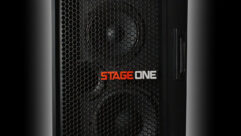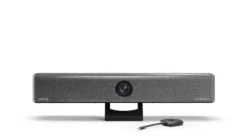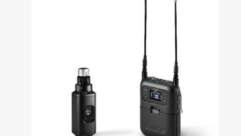
Technology Showcase: Wireless-microphone Systems
Jan 1, 2008 12:00 PM,
By Bennett Liles
The latest professional options offer serious “broadcast” capability.

Revolabs Solo Executive
The comment that wireless-microphone users were operating a radio station used to be fairly comical and quaint, but now that many wireless systems include transmissions of tones and telemetry, there is some serious broadcasting going on. Most professional equipment — including wireless IFB and in-ear monitoring systems — now uses pilot-tone muting, also known as tone squelch, to quiet receivers when transmitters are shut off. Battery-condition telemetry and other data signals have become common, as well. Dodging intermode and other types of interference has been automated, with computer-connected receivers trading data with their microphones. Digital transmission, encryption, and infrared wireless systems have also made their debut. Let’s take a look at some of the latest products in the wireless-microphone realm.
THE FIELD
The new AKG Acoustics D5 wireless-mic capsules introduced at InfoComm 07 are capable of operating with several AKG microphone systems, including the WMS 450, which is composed of the SR 450 receiver and the HT 450 handheld transmitter. Designed for rugged road use, the HT 450 can run for up to 8 hours on one AA battery, and it includes a spring-steel, wire-mesh cap. The microphone can be configured automatically from the receiver by IR link. The SR 450 has a programmable status display with a two-color backlight, a scanning function with a country-specific database, and a rehearsal function for finding dead spots. The WMS 450 D5 vocal set can be found for less than $800.
Anchor Audio offers the UHF 64-channel wireless system, which is composed of the UHF-6400 receiver, the WH-6400 handheld mic/transmitter, and the WB-6400 body-pack transmitter. Also available for the system are lapel, over-the-ear, and headband mics. The receiver includes group/channel-setting buttons, RF- and AF-level meters, volume control, and headphone output. On the rear panel are balanced-XLR and unbalanced 1/4in. output connectors. The transmitters are rechargeable from the receiver, and the WB-6400 transmitter has mic- and line-level switches and a low-battery indicator. Approximate retail prices on these are $310 for the WH 6400, $230 for the WB 6400, and $218 for the UHF 6400 receiver.
The Blue Class wireless system from Ansr Audio is a 700-channel set consisting of the AW-70 receiver; AW-2 or AW-3 transmitters; and AM-11, AM-14, AM-15, AM-16, or AM-17 microphones. The receiver front panel includes channel, frequency, and audio-level display; channel and volume-select switches; DC output for charging transmitters; and headphone output with volume control. The rear panel offers balanced-XLR and unbalanced 1/4in. audio output connectors and squelch control. The transmitters include a display showing channel and battery condition and channel-select switches located safely inside the battery compartment.

Audio-Technica SpectraPulse
Audio-Technica has taken a new approach to using ultrawideband (UWB) technology with its SpectraPulse system, introduced this year. The system employs a digital transmission technique in which brief nanosecond pulses of data are sent over a 500MHz-wide swath of spectrum. In a multi-microphone scenario, each microphone has its identity in the system set in hardware and synchronized with a receiver taking its turn at transmission in a time-division-multiplex access method. An optional encryption package is available that meets the NIST-approved 128-bit encryption standard. One receiver unit can handle seven mics in one rack space, and it can be linked to a second receiver for a 14-microphone system. Each Mtu101 boundary-mic transmitter retails for $1,300, and each audio control interface is $4,600.
The RAD-360 frequency-agile UHF wireless-mic system from Audix offers 193 frequencies for simultaneous operation of 12 to 16 transmitters. Soft-key controls operate menu-driven LCD displays for programming, signal strength, frequency, A/B antenna indicator, mute status, RF indicator, battery level, and lock status. The RAD-360 handheld transmitters feature interchangeable heads, and the body-pack transmitter can be used with the ADX10 lavalier mic, the ADX20i condenser mic, or the HT2 headset mic. The optional ADS-4 antenna distribution system can run four receivers on one pair of 3/4-wave antennas. The various system configurations range from $650 to $750.
The Azden 320ULT dual-channel system is an on-camera wireless-mic model that consists of one 320UPR receiver and two 30BT body-pack transmitters with EX-503L lapel microphones. The receiver features a digital readout and separate power switches for each channel, an important feature with this battery-powered system. Batteries can be recharged internally, and power can be taken from an external source. The receiver includes dual-XLR and stereo-mini output connectors, a removable shoe mount, and flexible antennas. The transmitters have a digital readout showing frequency selection and battery level. The system MSRP is $995.
Introduced at NAMM 2007, the Behringer Ultralink UL2000B headset system has 320 selectable frequencies for operation of up to 20 microphones simultaneously. The IRC compander automatically adjusts the expansion ratio when the signal goes below a predetermined threshold. The LCD shows a menu brought up by the set button, and it displays frequency, channel, RF level, and mute status. The rear panel features XLR and TRS output connectors along with a ground terminal. The ULB2000 transmitter offers a multifunction power button, mute switch, value selection dial for programming, and a status LED that blinks with varying speed for different messages. The UL2000B system lists for less than $300.
The Opus 900 from Beyerdynamic — built around either the NE 900 D 2-channel, the NE 900 Q 4-channel, or the NE 900 S single-channel receiver — features autoscan and automatic channel targeting through an IR link to the microphones. Adjustable output level, squelch, and programmable user name add control to as many as 16 simultaneous transmitter/receiver pairs. These can be used with the TS 900C and TS 900M body-pack transmitters and half a dozen different Beyerdynamic handheld microphones. Prices vary significantly depending on specific system components.
The Clockaudio CW9000R receiver is part of a system that includes the CW9001T belt-pack transmitter and the CW9000T handheld transmitter, and one that offers diversity reception with twin receiver circuits and balanced and unbalanced outputs in an all-metal case. The belt-pack transmitter tunes to 192 phase-locked loop (PLL) selectable frequencies displayed on an LCD along with battery status. The transmitter also includes audio-level control and a power switch. The unit can run for up to 8 hours on two AA batteries. The CW9000T has the same features, and it can fit either a dynamic or a condenser head. It is rated to run for 10 hours on two AA batteries, and it uses an integrated dipole antenna.
The Electro-Voice RE-2 wireless-mic system features a receiver with Digital Posi-Phase diversity and a tone code plus an amplitude-squelch function. The backlit LCD shows AF and RF levels, frequency, battery level, and active antenna, as well as group and channel numbers. Auto-ClearScan finds the most interference-free channel among 1,112 available. The RE-2 UHF handheld transmitter can fit any of three mic elements for a choice among dynamic, condenser, and dynamic with vocal-optimized bass. Batteries fit only one way to ensure proper insertion in low-light conditions. The RE-2 body-pack transmitter includes optional pouches to match a wide variety of microphones. The set with both transmitters and receiver is available for less than $700.
Among the options for the UF-series wireless-mic system from Gemini Sound is the UF-8264 receiver with 64 selectable frequencies, a group/channel display, a power indicator, an RF-level meter, an audio-output-level knob, and a DC charging port for the transmitter. The rear panel includes balanced and unbalanced audio connectors along with a manual squelch control. The FM-64 handheld transmitter can be fitted with either a dynamic or electret-condenser capsule. With the power switch, the unit features an LED to indicate battery condition. The FB-64 body-pack transmitter uses a mini-XLR mic connector, and it has the same features as the handheld model. The system with both transmitters and receiver can be found for about $200.
Lectrosonics provides a high-security wireless solution in the versatile UDR700 encrypted digital UHF diversity receiver with phase-based Rota-versity reception, adjustable audio output level, AES/EBU and analog audio outputs, a headphone jack with volume control, a phase switch, a ground lifter, and the capability to manually switch to either antenna for testing. The front panel includes 10-segment LED RF-level and audio-level metering. Used with the UM700 body-pack transmitter and the UT700 handheld microphone, the UDR700 applies 24-bit A/D conversion, 44.1kHz sampling, and digital signal processing, and it uses a multi-stage encryption process with a 128-bit key. The UDR700 can be found for just more than $3,000, and the UM700 is available for around $1,200.
1
Technology Showcase: Wireless-microphone Systems
Jan 1, 2008 12:00 PM,
By Bennett Liles
The latest professional options offer serious “broadcast” capability.

LightSpeed LT-71
The 880iR classroom-amplification system from LightSpeed Technologies is an infrared entry that includes the LT-71 LightMic IR microphone/transmitteroperating on 2.06MHz/2.54MHz or 3.2MHz/3.7MHz with a frequency response from 40Hz to 20kHz (-3dB). The 880iR receiver has four audio inputs with PageFirst emergency-page priority, teacher-voice priority, graphic EQ, and individual loudspeaker switches and volume controls. The unit can either take its IR signal from an SR70F IR sensor, or it can work with the RedCAT all-in-one integrated IR sensor, amplifier, receiver, and loudspeaker. The LT-71 mic can be worn on a neck loop to retain a line-of-sight link with the IR sensor. The primary advantage of such systems is low-cost communication security.
The ACT-82 dual-channel digital-diversity receiver from Mipro offers digital transmission with 24-bit audio sampling, 128-bit encryption, and 110dBA dynamic range. The full-color vacuum fluorescent display shows selected frequency/channel, AF and RF levels, and battery condition. Large systems can be controlled and configured with the Mipro RCS2.Net software application. The receiver is used with the ACT-8H handheld microphone with a detachable lithium-polymer battery pack. The LCD shows channel, battery level, input level, and error code. A 4-hour charge can power the microphone for 8 to 10 hours. The ACT-8T body-pack transmitter has removable soft antennas and a mini-XLR mic connector.
Among the wide variety of wireless products from Nady Systems is the U-1000 wireless-microphone system with 120dB dynamic range and up to 500ft. line-of-sight range. The receiver uses tone squelch, and the backlit LCD shows channel/frequency and RF and AF levels, along with A/B antenna-diversity status. The RF-scan feature helps dodge any frequencies with interfering signals, and the rear panel includes balanced-XLR and unbalanced 1/4in. audio output connectors. The UH-1000 handheld microphone features interchangeable heads with dynamic or condenser types available. There is a power switch, mute control, low battery, and mute LED with an LCD display. The UB-1000 body-pack transmitter can handle microphones and instrument inputs with a level switch and all the same features as the UH-1000. The system is available for around $750.
The Pro Comm PCX U-1002 handheld wireless system from Peavey can operate on any of 100 channels for live voice and guitar reproduction. The system features automatic channel scanning to avoid interference and easy setup of the transmitter’s channel-control system. The receiver has a color LCD display and XLR and 1/4in. audio output connectors. The MSRP on the Pro Comm PCX U-1002 system is $800.
Secure transmission is a prime feature of the Revolabs Solo Executive wireless-microphone system and the Solo Executive 8-channel system uses the company’s MaxFlex technology to provide two-way audio, plus wideband transmission and encryption in wearable, handheld, and boundary-table microphones. There are muting options including local and remote control, and the systems may be linked for use with up to 16 microphones in multichannel audio mixers or teleconferencing units. The Revolabs Solo Executive 8-channel system retails for $5,995.
With its SWM7000, Sabine has left VHF/UHF, and it has gone up to the 2.4GHz band with 70 channels, built-in DSP, and flat audio response from 20Hz to 20kHz. In the handheld transmitter, the choice of dynamic or condenser is augmented by pushbutton selection of virtual capsules that provide the mic with a number of response personalities. The SW75-T belt-pack transmitter runs on regular or rechargeable batteries, and it provides a backlit, programmable LCD. The SWM7000 receiver incorporates a feedback exterminator, parametric filters, a compressor/limiter, and an active de-esser. A 2-channel receiver with two handheld mics runs around $1,700.
The new AirLine Synth diversity system, shipping in 2008 from Samson Technologies, is a new frequency-selectable system that can operate on any of 320 frequencies over U.S. and European bands with up to 11 simultaneous channels. Featuring automatic channel scanning, infrared programming, balanced and unbalanced outputs, and a front- and rear-mountable antenna, the AirLine Synth system can be rackmounted with up to four receivers in a single rack space. The front panel displays AF/RF levels, frequency, audio output level, and channel mix setting. The AG-300 guitar transmitter is a unique, dual-mount jack that works on Gibson- or Fender-style outputs. It contains a precision guitar preamp, a digital LCD channel readout, a low-battery indicator, an attenuation switch for active pickups, and a mute switch for hot swapping. For handhelds, the AX-300 plugs directly into all dynamic microphones and comes with a Samson Q7 mic. The transmitter contains a precision mic preamp, a digital LCD channel readout, a low-battery indicator, and a mute switch. The AL-300 features a spring-steel belt clip, with a mini-XLR locking audio connector, precision mic and instrument preamps, an attenuation switch, and a mute switch for hot swapping. All the transmitters provide 10 hours of operation on their respective AA batteries, and they also accept infrared channel loading via the receiver.

Sennheiser SK-5212
The Sennheiser EM3032 2-channel receiver can tune to 32 frequencies on each of its receiving units, and the LCD shows AF and RF levels, battery condition, frequency/channel, active antenna, and mute status. It also offers separate headphone outputs. The very compact SK-5212 body-pack transmitter has a red LED to indicate power, peak audio level, and low battery. The power button is hidden safely inside the case next to a handy multifunction switch used to navigate display menus and set frequencies and other parameters, including the lock mode and bass rolloff. The MSRP on the SK-5212 transmitter is $3,600, and $4,225 for the EM3032 receiver.
The Shure SLX wireless system almost completely automates frequency selection and setup. The SLX4 receiver scans the available bands, finds clear channels, and then syncs the transmitters to these frequencies through an IR link on the front panel. The LCD shows group, channel, frequency, lock/unlock status, and transmitter battery level. The handheld transmitter has a two-position level switch, and the body-pack unit has a three-position switch for microphones and instrument input levels. Both transmitters feature a timed backlit LCD and frequency/power lockout. The SLX4 receiver retails for around $350, the SLX1 body-pack is just less than $200, and the SLX2 handheld can be found for less than $250.
Sony has an on-camera wireless-mic solution in the URX-P1/6264 tuner, providing space-diversity reception on TV channels 62 through 64 with a shoe mount for ENG/EFP-camera attachment and two angle-adjustable, 1/4-wave antennas. Featuring tone squelch, the system can operate up to 16 transmitter/receiver pairs over a range of 188 frequencies. The -58dBm audio level is output on a three-pole mini jack, and it provides a 50Hz-to-15kHz typical audio frequency response. The unit is capable of being paired with Sony transmitters including the UTX-H1/6264 handheld unidirectional mic and the UTX-B1C/6264 body-pack transmitter with omni lavalier mic.
The Telex FMR-1000 can operate in a setup with up to 16 systems over 950 possible frequencies, with ClearScan to quickly find the best channels. The front panel includes a parametric equalizer with screwdriver-adjustable level, Q, and frequency settings. In addition to the group, channel, frequency, battery status, diversity operation, and AF/RF levels, the LCD also shows a custom label to identify the audio source. The keyed battery compartment ensures proper insertion. The HT-1000 handheld transmitter can use either dynamic or condenser heads. The receiver features a balanced-XLR audio output and an unbalanced output connector with its own level. The three-element set can be found for less than $750.
TOA Electronics is preparing for the release of its new Trantec S5.5 wireless system in the form of the S5.5-HD-A handheld and the S5.5-L-A lapel wireless mic. The receiver offers two-receiver section diversity with more than 1,000 selectable frequencies in 10 selectable bands of 24 channels. The receiver output level is mic/line switchable, and the front panel includes a headphone output. Up to 24 systems can be simultaneously monitored with a USB computer link, and frequency selection can be set into the mics from the receiver by an IR link.
The Zaxcom TRX-900 system features all-digital transmission in the UHF range with unique features including a built-in IFB receiver and an internal 6-hour digital recording capability (12-hour option) with optional timecode. The system is capable of operating up to 30 transmitters simultaneously. The transmitter runs for 5 hours on a single battery, and it offers RF remote control of the body-pack transmitter. The RX-900M (mono) and RX-900S (stereo) receivers have a 4-hour battery run time, mic and line audio input selects, and 24-bit D/A conversion. The RX-4900 is a four-receiver rackmount unit. The RX900M and RX-900S receivers list for around $2,000, and the TRX-900 transmitter is around $1,850.
Bennett Lilesis a freelance television production engineer and AV technician in the Atlanta area. He specializes in government video production, distance learning, and videoconferencing.
For More Information
AKG Acoustics
www.akg.com/us
Anchor Audio
www.anchoraudio.com
Ansr Audio
www.ansraudio.com
Audio-Technica
www.audio-technica.com
Audix
www.audixusa.com
Azden
www.azdencorp.com
Behringer
www.behringer.com
Beyerdynamic
www.beyerdynamic.com
Clockaudio
www.clockaudio.com
Electro-Voice
www.electrovoice.com
Gemini Sound
www.geminidj.com
Lectrosonics
www.lectrosonics.com
LightSpeed Technologies
www.lightspeed-tek.com
Mipro
www.mipro.com.tw
Nady Systems
www.nady.com
Peavey
www.peavey.com
Revolabs
www.revolabs.com
Sabine
www.sabineusa.com
Samson Technologies
www.samsontech.com
Sennheiser
www.sennheiserusa.com
Shure
www.shure.com
Telex
www.telex.com
TOA Electronics
www.toaelectronics.com
Zaxcom
www.zaxcom.com
2










